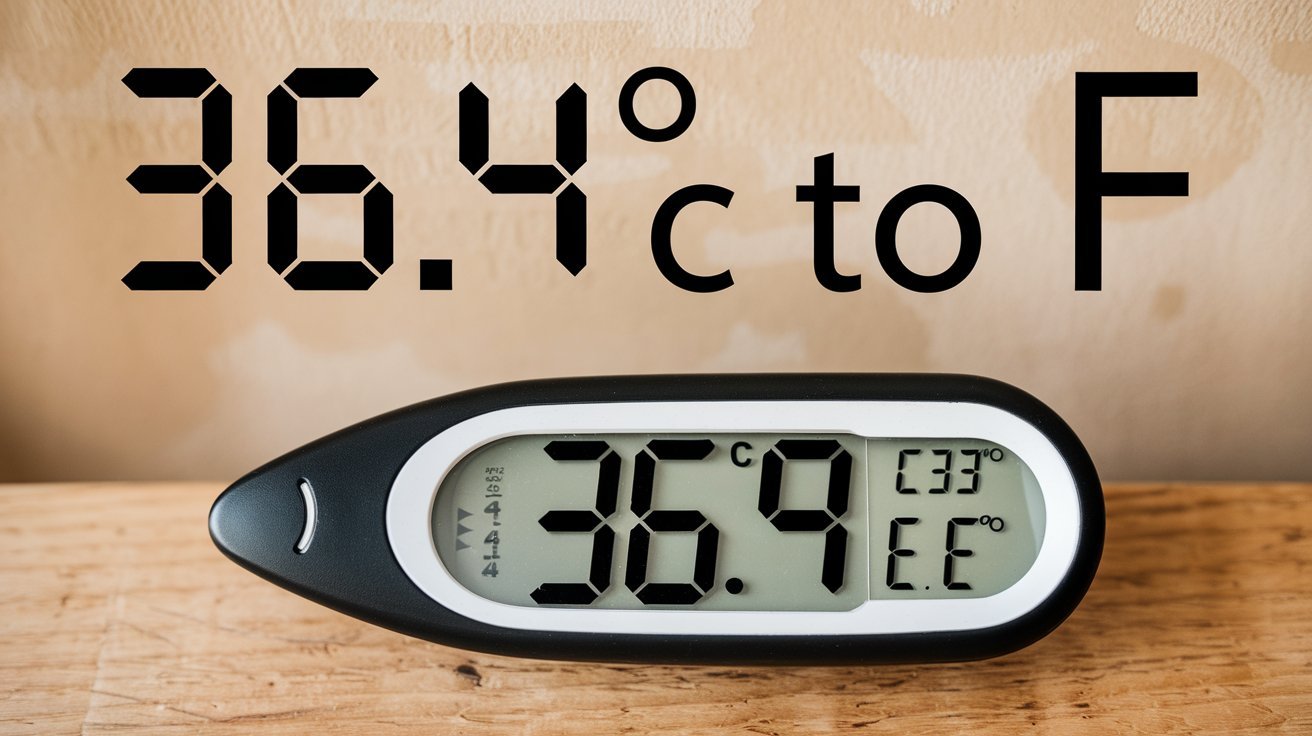Understanding Temperature Conversion: 36.4 c to f
Introduction
Have you ever found yourself staring at a temperature reading in Celsius, wondering, “How do I convert this to Fahrenheit?” If so, you’re not alone! Temperature conversions can seem like a tricky puzzle, especially when they involve real-world applications like cooking, weather forecasts, or health assessments. Today, we’re going to break down the conversion of 36.4 c to F and explore why understanding temperature scales is essential.
The Basics of Temperature Scales
Before we dive into the conversion, let’s take a moment to understand the two main temperature scales: Celsius (°C) and Fahrenheit (°F).
- Celsius is commonly used in most countries around the world and is based on the freezing point of water (0°C) and the boiling point (100°C). It’s the go-to scale for scientists and most people outside the United States.
- Fahrenheit, on the other hand, is primarily used in the United States and a few other countries.
Understanding these two scales is the first step toward grasping how to convert 36.4 c to f. Each scale reflects different historical approaches to measuring temperature, and knowing their context can help you appreciate why they’re used differently around the world.
The Conversion Formula
To convert Celsius to Fahrenheit, you can use this simple formula:
F=(C×95)+32F = \left( C \times \frac{9}{5} \right) + 32F=(C×59)+32
Where:
- FFF is the temperature in Fahrenheit.
- CCC is the temperature in Celsius.
This formula is derived from the relationship between the two scales and provides an easy way to make conversions. So, for our example of 36.4 c to f, we can plug in the values.
Performing the Calculation
Let’s calculate the temperature step by step:
- Start with the Celsius temperature: 36.4°C.
- Multiply by 95\frac{9}{5}59:
36.4×95=65.5236.4 \times \frac{9}{5} = 65.5236.4×59=65.52 - Now, add 32 to that result:
65.52+32=97.5265.52 + 32 = 97.5265.52+32=97.52
Therefore, 36.4 c to f is equal to 97.52°F. Simple, right?
This straightforward calculation shows how easy it can be to shift between scales once you know the formula.
Why It Matters: Practical Applications
Understanding how to convert 36.4 c to f isn’t just a math exercise; it has real-world implications. Here are a few scenarios where this knowledge is crucial:
- Cooking: Many recipes list temperatures in Fahrenheit. Knowing how to convert ensures your dishes come out just right. Imagine baking a cake at the wrong temperature because you didn’t convert accurately—yikes!
- Weather Forecasts: If you’re traveling to a country that uses Celsius, you’ll want to know what the temperatures feel like in Fahrenheit, especially if you’re not accustomed to the metric system. A 36.4 c to F day might sound pleasant, but it’s essential to know how that translates to your comfort level.
- Health Monitoring: Body temperature is often measured in Celsius in many places. If your thermometer reads 36.4°C, knowing it translates to 97.52°F can help you understand your health status better. This knowledge can be particularly useful if you’re feeling under the weather.
The Science Behind Temperature
Temperature indicates how hot or cold an object or environment is. In scientific terms, it indicates the average kinetic energy of the particles in a substance. Higher temperatures mean faster particle movement.
This concept becomes particularly interesting when you consider the difference in temperature perception between Celsius and Fahrenheit. For instance, a body temperature of 36.4 c to F (or 97.52°F) is considered normal, but how we interpret “normal” can differ based on which scale we use.
Temperature also plays a crucial role in various scientific fields, from meteorology to medicine. Understanding how temperature affects physical and biological processes can lead to more effective applications in daily life.
Fun Facts About Temperature Scales
Now that we’ve covered the basics, let’s take a moment to enjoy some fun facts about temperature:
- Freezing and Boiling Points: While water freezes at 0°C and boils at 100°C Celsius, in Fahrenheit, these points are 32°F and 212°F, respectively. This quirky difference can lead to amusing misunderstandings!
- Body Temperature: The average human body temperature is typically around 37°C (98.6°F), but some people may have normal temperatures that vary slightly. If you ever wondered why your temperature seems “off,” it could just be that you’re measuring it on the wrong scale!
- Historical Tidbits: The Fahrenheit scale was developed by Daniel Gabriel Fahrenheit in the early 18th century. He based his scale on two fixed points: the temperature of ice water (32°F) and the human body (which he originally estimated to be around 96°F). Understanding this history helps contextualize why different cultures prefer different measurement systems.
A Lighthearted Look at Temperature
Sometimes, temperature conversations can get a bit dry—pun intended! To keep things lively, here’s a humorous take:
Imagine someone from the U.S. visiting Europe in the summer. They see a forecast of 30°C and think, “Wow, that sounds nice!” Only to go outside and feel like they’ve just walked into a boiling sauna! That’s the kind of moment that makes you appreciate understanding 36.4 c to f.
The misunderstanding doesn’t stop there. How many times have you told a friend it’s a balmy 20°C outside, only to receive a puzzled look in response? Clearly, temperature conversion can be a source of both confusion and amusement.
Practical Tips for Temperature Conversion
If you often find yourself needing to convert temperatures, here are a few tips to make the process easier:
- Memorise Key Numbers: Knowing a few key conversion points can help. For example, 0°C = 32°F and 100°C = 212°F are essential reference points. These numbers can serve as a mental shortcut when you need quick conversions.
- Use Online Tools: There are plenty of online calculators and conversion tools available. A quick search for 36.4 c to f will yield results instantly! In today’s digital age, technology can save us from math headaches.
- Practice Makes Perfect: The more you practice converting temperatures, the easier it becomes. Try converting other common temperatures, like the ideal baking temperature or a typical body temperature. With time, you’ll develop a natural feel for the conversions.
The Importance of Accurate Measurements
In fields like medicine and cooking, accuracy is paramount. A slight miscalculation in temperature can lead to significant outcomes. For example, cooking chicken at the wrong temperature could lead to foodborne illnesses. Likewise, understanding your body temperature can indicate potential health issues.
This highlights why learning to convert 36.4 c to f accurately is not just a fun exercise but an essential skill. Inaccuracies in measurement can have real consequences, whether it’s a ruined dish or an overlooked health condition.
Real-Life Scenarios: When You Need to Know
Let’s explore a few scenarios where knowing how to convert 36.4 c to f could be beneficial:
Scenario 1: Cooking
You’re trying out a new recipe that calls for baking at 350°F. Your oven is set in Celsius, and you’re not sure how to get the right temperature—knowing that 36.4 c translates to 97.52°F can help you navigate the cooking process more effectively. It’s all about making sure your meals are both delicious and safe to eat!
Scenario 2: Health Monitoring
Imagine you’re feeling under the weather, and your thermometer reads 36.4°C. You want to ensure you’re within a normal range. Converting this to 97.52°F helps you understand that you’re not running a fever, which can be reassuring. Keeping track of your body temperature is a simple yet effective way to monitor your health.
Scenario 3: Travel Planning
You’re organizing a visit to a country that measures temperature in Celsius. Checking the weather forecast shows 36.4 c to F for a particular day. Converting this to 97.52°F can help you prepare for the heat, making sure you pack the right clothes! No one wants to be caught wearing jeans on a sweltering summer day, right?
Common Mistakes in Temperature Conversion
While converting temperatures may seem straightforward, there are common pitfalls to avoid:
- Forgetting the Formula: Always remember the formula F=(C×95)+32F = \left( C \times \frac{9}{5} \right) + 32F=(C×59)+32. Skipping a step can result in inaccurate outcomes. Double-check your math to ensure accuracy.
- Confusing the Scales: Be mindful of which temperature scale you’re working with. Mixing up Celsius and Fahrenheit can lead to amusing yet unfortunate mishaps! “It’s only 10°F outside? Perfect for a swim!” (Spoiler: Not so much.)
- Neglecting the Context: Understand the context in which you’re using the temperature. For example, a 36.4 c to fday in the desert feels entirely different than a 36.4 c to f day in a humid rainforest! Always consider how the temperature translates to real-life conditions.
Conclusion
In conclusion, understanding how to convert 36.4 c to f is not just a math problem; it’s a practical skill that can enhance your daily life. From cooking to health monitoring and travel planning, knowing how to navigate between Celsius and Fahrenheit opens up a world of possibilities.
So, the next time you find yourself pondering temperature conversions, remember this guide. With a bit of humor and a lot of practical information, you can confidently tackle any temperature question.
And who knows? You might even wow your friends with your newfound expertise! After all, in a world full of hot and cold moments, being able to convert 36.4 c to F is a cool skill to have!














Post Comment